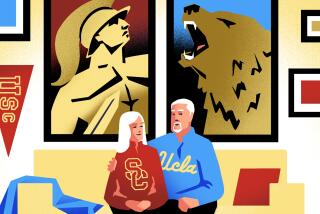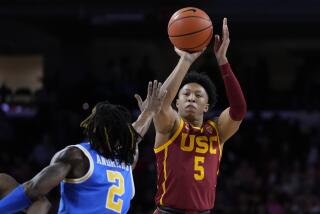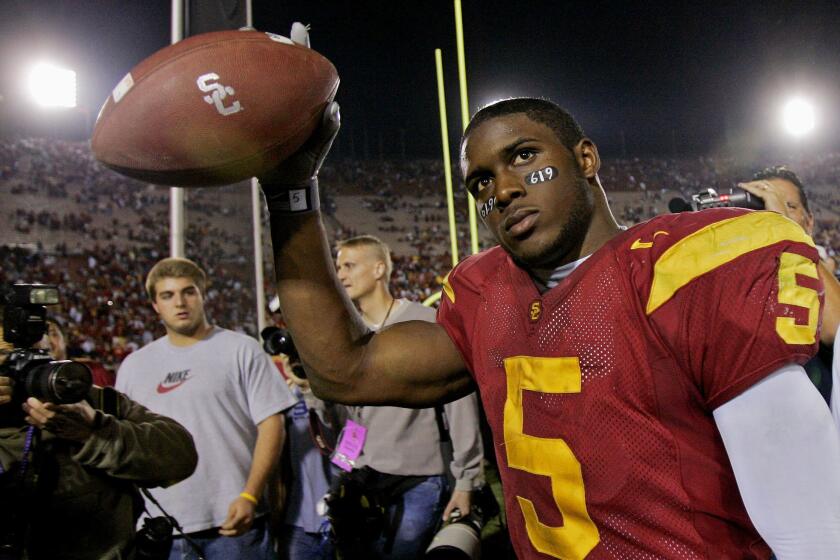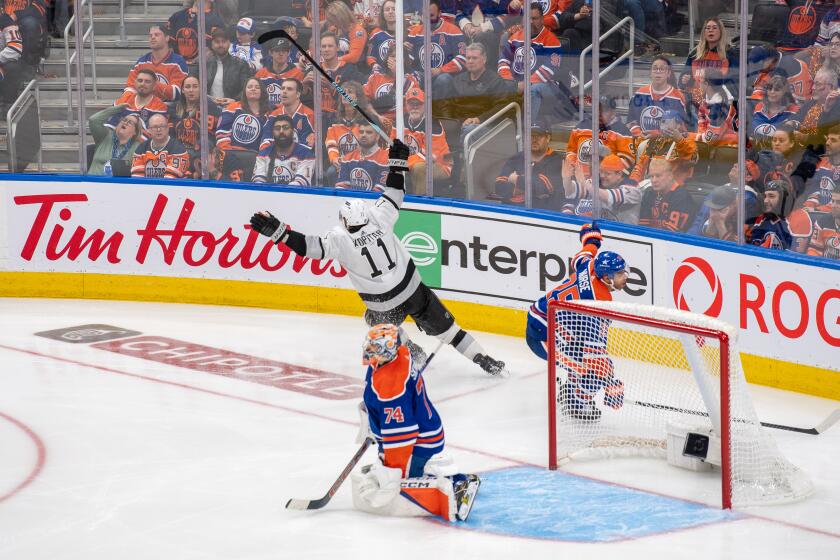These go-betweens are right in middle of USC-UCLA rivalry
A young Jeff Fisher slumped in front of his locker, head down.
The USC defensive back had just let an interception slip away, into the hands of UCLA running back Freeman McNeil, for a long touchdown that gave the Bruins a 20-17 victory in the 1980 game.
Fisher was disconsolate, so the school’s sports information director, Tim Tessalone, approached him carefully.
“Jeff, you don’t have to do this,” Tessalone said. “But all the media want to talk to you.”
As the buffer between Trojans athletes and reporters for almost three decades, Tessalone has experienced all sorts of moments -- good and bad -- surrounding USC-UCLA games. Same goes for his counterpart, Marc Dellins, the Bruins’ longtime spokesman.
“You work with these coaches, with the student-athletes,” Dellins said. “There’s joy when you win. You see the pain that losing causes.”
Both Tessalone and Dellins graduated from the schools where they now work, so to some degree they are fans. But their jobs, as well as their inside access, give them a distinctive insight into the crosstown rivalry.
The Good
So many stars have played in the annual game, a litany of Heisman Trophy winners that stretches from Mike Garrett and Gary Beban to Matt Leinart and Reggie Bush. Yet, when Tessalone and Dellins are asked for their favorite football recollections, they mention two lesser-known names.
For Dellins, it was John Barnes.
The year was 1992 and the Bruins had run through pretty much all of their quarterbacks, losing Wayne Cook, Rob Walker and Ryan Fien to injury. They were down to a fourth-string senior.
“He wasn’t even on the team the previous year,” Dellins said. “Coach [Terry] Donahue let him walk on.”
Barnes responded with a magical night against the Trojans, throwing for 385 yards and three touchdowns. When 15th-ranked USC failed on a two-point conversion with less than a minute remaining, UCLA had a 38-37 upset victory.
Dellins loved that a no-name could, in the course of a few hours, become a star. He also liked the way Barnes responded afterward. The quarterback, known to live in a realm of his own, did not consider his Cinderella performance a big deal.
Interviewed on television after the game, he was asked what might have happened if USC had taken the lead on that conversion.
“Well,” he responded plainly, “we’d have gone down the field and scored again.”
Tessalone’s favorite story dates to 1979, his first year on the job. The fourth-ranked Trojans, on their way to an undefeated season, held a big lead against UCLA as he made his way from the press box to the field.
Walking down the stadium stairs, he watched little-used USC tailback Michael Hayes run for a late touchdown. It was a meaningless score in a 49-14 victory, but Tessalone was struck by Hayes’ sheer joy.
“I remember him making this great run, somersaulting in the end zone,” Tessalone said. “Here’s a guy who labored in the shadows of Charlie White and he got his little moment.”
That was when Tessalone appreciated the significance of the rivalry.
“It’s not all about the stars,” he said. “Everybody who plays in that game gets to relish it.”
The Bad
Usually, the bad part comes after a loss when Tessalone and Dellins find themselves caught between anguished players and reporters who want to ask questions. Which goes back to the story about Fisher.
After the 1980 game, Tessalone tried to be tactful with the senior. Twenty-seven years later, the moment remains vibrant not because of its awkwardness, but because of what happened next.
Fisher looked up and said: “Let’s go.”
Tessalone calls it a first glimpse at the man who now ranks among the NFL’s veteran coaches.
“He stood there for 20 minutes and faced the media and answered all their questions,” Tessalone said. “It’s easy to talk when you just scored the winning touchdown and so difficult to talk in times of adversity, but that’s when people find out what you’re all about.
“We found out about Jeff Fisher.”
Asked about the interaction between team and media, Dellins mentions a different sort of memory.
In 1977, the Bruins had a shot at the Rose Bowl but lost to USC, 29-27, on a field goal by Frank Jordan with two seconds remaining.
“That was a heartbreaker,” Dellins said. “You go from Rose Bowl to no bowl because we didn’t end up going anywhere that year.”
Donahue, in his second year at UCLA, was ushered into the visitors’ interview room at the Coliseum, not much more than a concrete hallway. Dejected, he sat down on the floor.
A radio reporter asked him: Can you think of a tougher way to lose a game?
“I’ll never forget . . . just the emotion of it,” Dellins recalled. “Donahue looked up at the guy with this look on his face and said: ‘Next question.’ ”
The Job
Rivalry week means more work for the sports information directors. More interview requests at practice, more reporters calling for credentials and more seats to squeeze into the finite space of a press box.
The pace gets especially hectic if both teams are nationally ranked or, like this year, playing for a Rose Bowl berth. “You get the people that you only hear from once every few years,” Dellins said. “You’re going to take care of the people who cover you on a regular basis, the national publications, the ESPN.coms.”
Along with the big gains and final scores, Dellins recalls the players who worked best with the media.
“Troy Aikman was always good,” he said. “Jerry Robinson and Kenny Easley. A guy like Freddie Mitchell was ready to do any interview.”
For Tessalone, nothing compares with 1988, the year that Rodney Peete came down with the measles.
The Trojans quarterback, a Heisman Trophy candidate, called the sports information department on the Sunday of UCLA week, saying that he did not feel good.
“Rodney was a great practical joker,” Tessalone said. “He was always calling the office, saying he was the LAPD and they had just picked up Rodney Peete. So I said, ‘Yeah, right.’ ”
When it became evident that he was truly sick, USC put him in a hospital away from campus, hoping to shield him from the media. As it turned out, a local sportscaster visited that hospital for some tests and spotted Peete.
“So we had to move him again because people kept calling him,” Tessalone said.
Peete rejoined the team for light workouts late in the week. USC closed the Friday practice, Tessalone said, so television news crews stood on their vans to peer over the fence and a photographer found an opening just large enough to snap a picture of the quarterback.
It became a part of USC-UCLA lore when Peete played on Saturday, leading the second-ranked Trojans to a 31-22 victory over Aikman and the sixth-ranked Bruins.
Fans might recall that the USC quarterback played well under the circumstances, passing for one touchdown and running for another.
But for Tessalone and Dellins, the things that happen before and after games can be even more memorable.
“It’s more work but that’s the fun,” Dellins said. “This is what everybody waits for.”
More to Read
Get our high school sports newsletter
Prep Rally is devoted to the SoCal high school sports experience, bringing you scores, stories and a behind-the-scenes look at what makes prep sports so popular.
You may occasionally receive promotional content from the Los Angeles Times.







